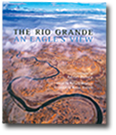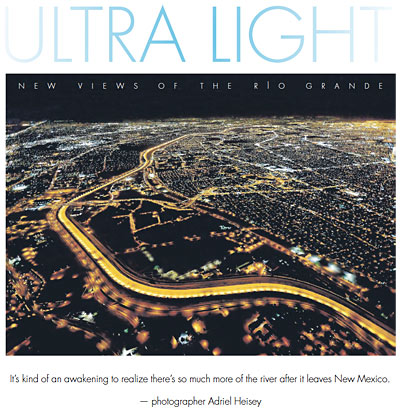Reviews & Press
Featured Article
New Mexican Magazine | August 2011
The idea of free-flowing water has a paradisiacal aspect in a dry year like this, and viewing Adriel Heisey's photographs in The Río Grande: An Eagle's View is especially joyful.
 This is not the first book to feature pictures of the
big river from its source in southwestern Colorado to
its mouth at the Gulf of Mexico. Laura Gilpin did it
in 1949 in The Río Grande, River of Destiny: An Interpretation of the
River, the Land, and the People. "I would love to learn more about
that book," Heisey said in a recent interview from his home in
Gallup. "I remember seeing a black-and-white print of hers in the
Roswell Museum a few years ago that was so beautiful. It was of
the final miles of the river, a very abstract aerial photo: the winding
meanders and the contrasting light surfaces of the reflecting water
and the dark marshes."
This is not the first book to feature pictures of the
big river from its source in southwestern Colorado to
its mouth at the Gulf of Mexico. Laura Gilpin did it
in 1949 in The Río Grande, River of Destiny: An Interpretation of the
River, the Land, and the People. "I would love to learn more about
that book," Heisey said in a recent interview from his home in
Gallup. "I remember seeing a black-and-white print of hers in the
Roswell Museum a few years ago that was so beautiful. It was of
the final miles of the river, a very abstract aerial photo: the winding
meanders and the contrasting light surfaces of the reflecting water
and the dark marshes."
His images possess a striking clarity. One reason for that is that he captured them flying as slowly as 40 miles per hour—and sometimes even slower heading into a wind. He began the project using his Kolb Twinstar, an ultralight-type aircraft with an open cockpit. "It was pretty minimalist, but the benefit was being able to fly slowly, and it was very economical. Because it was so slowflying, I could not go on long trips. But I could fold it up in 10 minutes and put it in a trailer. For the Río Grande project, I had to trailer hundreds of miles, and I camped in the trailer."
All that trailering took away from air time, and after 16 years with the Kolb, he changed to a Flight Design CT, an airplane in the light-sport category. The beefier plane facilitated longer flights, but it still permitted air speeds down to 40 mph: a necessity for those super-clear photos, which are also enabled by his use of a gyrostablizer under the camera, and by his experience. "I do have to master all these technical things, but what motivates me in the first place is the power of the perspective, seeing the earth from the air," he said. "That has moved me since I was a teenager, and it's what inspired me to fly in the first place. There's something almost godlike in being able to see everything at once. When you have a subject like the river, it's a wonderful thread of connection from one place to another place, with radically different landscapes and qualities."
The Río Grande: An Eagle's View (www.theriograndeaneaglesview. com) is published by the Santa Fe organization WildEarth Guardians. The book's main text is by Steve McDowell, and it features essays by U.S. senator Tom Udall and by actor/environmentalist Robert Redford. It is WildEarth Guardians' first book. "Because of the budget limitations, it was done over a decade's time, but because of that, Adriel had the opportunity to catch the river in so many seasons and moods," said John Horning, the organization's executive director. Horning is scheduled to appear at a reception for the book
 He said the Río Grande has been an important focus for WildEarth
Guardians since April 1996, when about 60 miles of the river went
dry. "Drought definitely played a role, but it was also from irrigators
and municipalities diverting so much," Horning said. "That was
a catalyzing moment, because you realize that all of the river's
water is spoken for. That's a policy we need to change, but one of
the strengths of a book like this is that, regardless of your political
"
He said the Río Grande has been an important focus for WildEarth
Guardians since April 1996, when about 60 miles of the river went
dry. "Drought definitely played a role, but it was also from irrigators
and municipalities diverting so much," Horning said. "That was
a catalyzing moment, because you realize that all of the river's
water is spoken for. That's a policy we need to change, but one of
the strengths of a book like this is that, regardless of your political
"
This is the fourth book featuring photography by Heisey, whose day job is flying for the Navajo Nation. The others are Under the Sun: A Sonoran Desert Odyssey (2000), In the Fifth World: Portrait of the Navajo Nation (with Kenji Kawano, 2001), and From Above: Images of a Storied Land (2004), a catalog published by The Albuquerque Museum of Art & History in conjunction
The Río Grande book was Horning's idea. He conceived it after seeing a Heisey photo of a stream in Canyon de Chelly, part of a National Geographic cover story on the Four Corners landscape. "Our original project was just from the headwaters to El Paso, the upper third of the river," Heisey said. "It wasn't until about four years ago that we decided to go all the way. It's kind of an awakening to realize there's so much more of the river after it leaves New Mexico. It did change the character of the project a little to add that dimension.
 "I have been told by Texas natives that the people there
regard the Río Grande as their own river, and they will
probably see this book as primarily a Texas-themed enterprise,
just like we see it as more New Mexico-centric."
Heisey is a self-taught photographer. He bought his
first camera the year he graduated from high school in
Newville, Pennsylvania. At that point, he already had
a student pilot's license. He made a religion of having
his camera with him as he began working as a pilot and
flight instructor. He tried to capture what he was "seeing
and feeling out the window of the airplane," as he put it.
By the time he moved to the Southwest at 26, his photographic
eye and technique had matured significantly.
"I have been told by Texas natives that the people there
regard the Río Grande as their own river, and they will
probably see this book as primarily a Texas-themed enterprise,
just like we see it as more New Mexico-centric."
Heisey is a self-taught photographer. He bought his
first camera the year he graduated from high school in
Newville, Pennsylvania. At that point, he already had
a student pilot's license. He made a religion of having
his camera with him as he began working as a pilot and
flight instructor. He tried to capture what he was "seeing
and feeling out the window of the airplane," as he put it.
By the time he moved to the Southwest at 26, his photographic
eye and technique had matured significantly.
"Before that, I was using the camera with the idea that the photos would be sketches for paintings; it was my dream to record exciting visual elements of what I was seeing in the air. But there was also something about the painting experience. It had a spaciousness about it that I was really longing for as an artist; that is, to have a contemplative experience of working the image, spending lots of time with it and working on nuances and exploring the "
After his move to the Southwest, Heisey lived in Window Rock and had begun flying Navajo Nation tribal leaders to various places. If there was a leg on a flight with no passengers, he could practice his craft, banking steeply to shoot straight down or doing whatever it took to keep parts of the airplane out of the frame of the photograph. At a certain point, he began to get results that made him think the photography could stand alone. With that realization, he decided he wanted to fly lower and slower. That's when he decided to build his own airplane, the Kolb Twinstar.
The small aircraft offered the flexibility he desired, and it also assured a real sense of connection with the lands below. "The area of the Río Grande headwaters is probably the most memorable place to fly, partly because it's so challenging and extreme up there. I amdressed for flying with the door open to minus 15 degrees, so if I was put into a survival situation, I'm pretty well equipped. I'm flying this tiny little airplane with one engine, so vulnerable to all kinds of things, so it's a constant idea that I might have to be on the ground and work my way out."The airplane is near the limit of its capabilities, and if something does go wrong, there are much fewer options for dealing with emergencies because of the terrain and altitude. And yet it really is one of the most magical places on the river, because it's the beginning, where all these delicate threads begin to collect into the larger cord of the river. To be up there when the landscape is almost completely covered by snow, it's like a world apart."


